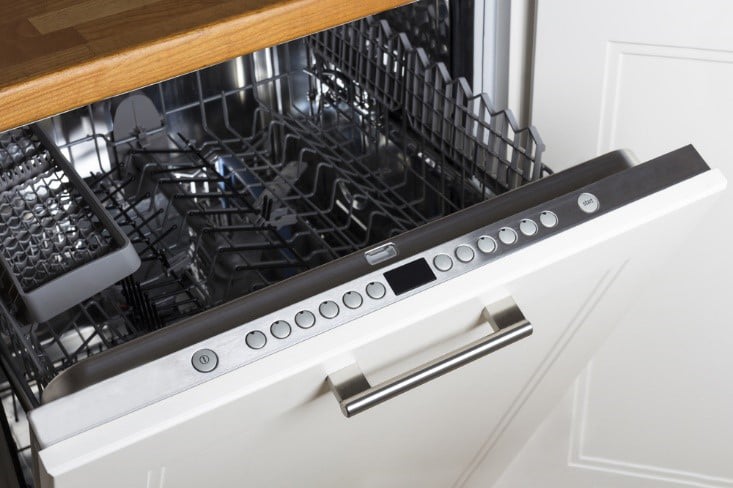Smelly Dishwasher? 5 Easy Steps to Clean Out Your Dishwasher

A dishwasher is meant to clean your dishes, not stink up your kitchen. Cleaning your dishwasher doesn't need to be hard. AHS has five easy steps to get rid of that stinky dishwasher smell.


A dishwasher is meant to clean your dishes, not stink up your kitchen. Cleaning your dishwasher doesn't need to be hard. AHS has five easy steps to get rid of that stinky dishwasher smell.
A dishwasher is meant to clean your dishes, not stink up your kitchen. Cleaning your dishwasher doesn't need to be hard.
If you’re anything like us, your dishwasher is among your most-loved and hardest-working appliances. Without it, you’d be shackled to the sink every night, washing all your dirty dishes by hand. The dishwasher saves you time and energy and keeps your hands clean.
But a lot of dirty dishes go into your dishwasher, and over time, that food residue can build up and get stinky. That’s why lists of tips to keep your dishwasher from smelling include giving it a regular, and thorough, cleaning. Follow these steps to make your smelly, dirty dishwasher clean and odorless once more.
You don’t need a lot of sophisticated equipment to clean your dishwasher, and you don’t need to put harsh, toxic chemicals like bleach in your dishwasher to clean, deodorize, or sanitize it. Here’s what you need:
You’ll also want a sponge and some hot, soapy water to wipe down the exterior of your machine when you’re done freshening up the inside.
If your dishwasher isn’t spraying correctly, it may not need an expensive repair. The sprayer arm might be getting hung up on a dish that has dropped below the rack, or the holes in the arm itself might be clogged with food particles. Use your picture-hanging wire or toothpicks to unclog the holes in the sprayer arms. You can remove the dish racks and the sprayer arms themselves to make this easier.
To keep your dishwasher smelling fresh, check the spray arms for gunk about once a week, and unclog the holes in them as needed.
Thinking about coverage?
Security for your home. Protection for your budget.
A clogged dishwasher filter could prevent your dishwasher from draining completely, and it’s worth checking before you schedule dishwasher repairs to fix this problem. Pull out the filter and scrub it with your old toothbrush. If you’ve been having draining problems, inspect the drain for clogs. You may be able to pull them out with your fingers or with a plumber’s snake.
While you’ve got the dish racks out, go ahead and give them a good wipe-down, too. Examine the finish for signs of wear. If the finish on your dishwasher racks has worn down to the metal, you can buy a dishwasher rack repair coating to restore it. This will keep your dishwasher racks from rusting.
Keep your dishwasher running smoothly and smelling good by checking the drain and cleaning the filter weekly, at the same time as you’re checking your spray arms. Most dishwasher filters these days need to be manually cleaned, but if you’ve got a self-cleaning dishwasher, you may not need to check the filter as often.
Now it’s time to de-scale, disinfect, and deodorize the interior of your dishwasher. You can buy dishwasher detergent for this, but DIY dishwasher cleaning solutions are cheap and easy to make. You can clean your dishwasher with vinegar, and then put baking soda in the dishwasher for another cycle to deodorize it.
Start by putting a cup of vinegar on the top rack of your empty dishwasher. Run the machine through a hot water cycle. This should de-scale the dishwasher, disinfect it, and remove any greasy buildup inside.
Next, sprinkle a cup of baking soda into the bottom of your dishwasher. Run the dishwasher again through a short, hot water cycle. This will remove any lingering odors from inside your dishwasher, and should also scrub away any stains. You should clean out the interior of your dishwasher with vinegar and baking soda about once a month.
Now that you’ve cleaned out the inside of your dishwasher, it’s time to clean the exterior. If you have a stainless-steel dishwasher, you can use glass cleaner to remove dirt, residue, and fingerprints from the surface. Otherwise, hot soapy water should do the trick.
However, avoid spraying any cleaner or liquid directly onto the dishwasher’s exterior, as this could damage the controls. Apply the cleaner or soapy water to a washcloth, paper towel, or sponge first, and then use that to wipe down the outside of the dishwasher.
Nobody likes a smelly dishwasher, but with all the grimy food residue that goes into our dishwashers, it’s no surprise that they can get pretty gross if they’re not cleaned regularly. A smelly dishwasher isn’t just unpleasant to use – it can also be less effective at getting your dishes clean. Make sure you clean your dishwasher regularly. It will keep it smelling fresh, and help it run smoothly, so you can spend the rest of your evening relaxing, instead of standing at the sink.
Your dishwasher is an important appliance in your kitchen, one that simplifies your life and makes cleanup easier. Because of its frequent use, this appliance is also susceptible to occasional malfunctions and breakdowns. Consider an American Home Shield® Home Warranty that helps cover these seemingly inevitable repairs.
See how a home warranty plan steps in when your dishwasher’s not doing its job.

AHS assumes no responsibility, and specifically disclaims all liability, for your use of any and all information contained herein.
Have a plan for your home when things don't go according to plan
Shop Home Warranties